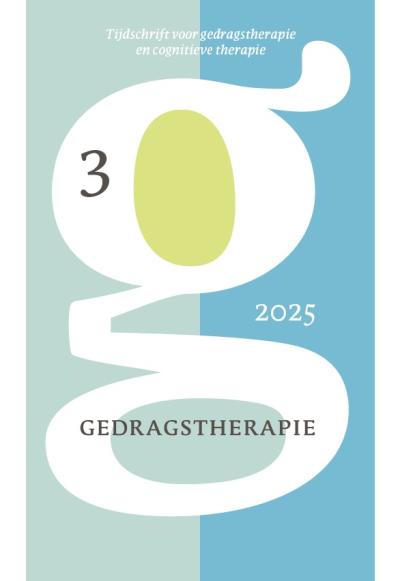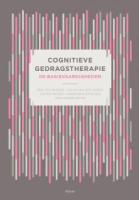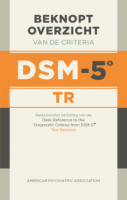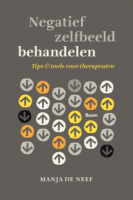Inhoud
Plegers van Seksueel Delictgedrag: etiologie, assessment en interventies
Samenvatting
Dit artikel geeft een beknopt overzicht van etiologie, assessment en interventies bij plegers van seksuele delicten. Naast het confluentie model en de biopsychosociale leertheorie is er aandacht voor de rol van cognitieve vervomtingen, seksuele deviantie en zelfregulatie in de aanloop naar seksueel delictgedrag. Daarnaast wordt een nieuw theoretisch kader geintroduceert: een stimulus model voor seksuele motivatie. De beschrijving van de assessment van plegers van zedendelicten valt uiteen in enerzijds een bewchrijving van zowel statische als dynamische taxatie van het risico van herhaling, als anderzijds een beschrijving van de diagnostiek van de specifieke risicofactoren: deviante interesse/voorkeur, hyperseksualiteit en seksuele coping. In het overzicht van behandelvormen ligt de nadruk op het risk, need, responsivity model, gevolgd door beschrijving van de basiselementen van behandeling voor laag/matig- en hoog-risico plegers. Voor een uitgebreide beschrijving van de behandeling van een hoog risico pleger verwijzen we naar de casus (Holwerda & Van Beek) in dit dit themanummer.
Literatuur
- Abel, G.G., Jordan, A., Hand, C.G., Holland, L.A., & Phipps, A. (2001). Classification models of child molesters utilizing the Abel Assessment for Sexual Interest. Child Abuse and Neglect, 25, 703–718.
- Agan, A.Y. (2011). Sex offender registries: Fear without function? Journal of Law and Economics, 54, 207-239.
- Ahlers, C.J., Schaefer, G.A., Mundt, I.A., Roll, S., Englert, H., Willich, S.N., & Beier, K.M. (2011). How unusual are the contents of paraphilias? Paraphilia associated sexual arousal patterns in a community-based sample of men. The Journal of Sexual Medicine, 8, 1362-1370.
- Andrews, D.A., & Bonta, J. (2010). The psychology of criminal conduct (5th ed.). Newark, NJ: LexisNexis.
- Andrews, D., Bonta, J., & Hoge, R. (1990). Classification for effective rehabilitation: Rediscovering psychology. Criminal Justice and Behavior, 17, 19-52.
- Andrews, D.A., Bonta, J., & Wormith, S. J. (2011). The Risk-Need-Responsivity (RNR) model: Does adding the good lives model contribute to effective crime prevention? Criminal Justice and Behavior, 38, 735-755.
- Beech, A., & Fisher, D. (2004) Treatment in prison and probation settings. In H. Kemshall (Ed.) Research highlights in social work: Managing sex offender risk (pp. 137-163). London: Jessica Kingsley Publishers.
- Beech, A.R., Fisher, D., Beckett, R. C. (1999). An Evaluation of the Prison Sex Offender Treatment Programme. UK Home Office Occasional Report.
- Beek, D.J., van, & Berg, J.W., van den (2009). Seksueel geweldplegers tegen vrouwen: Een klinisch groepsprogramma. 2e editie. Utrecht: Forum Educatief.
- Beek, D.J. van, Mulder, J. (2002). De rol van cognitieve vervormingen in het plegen van pedoseksuele delicten en hun plaats in de behandeling. Tijdschrift voor Seksuologie, 26, 79-86.
- Beek, D.J. van, & Mulder, J.R. (2007). Het zelfregulatiemodel in delictroutes. Utrecht: Forum Educatief (Nederlandse bewerking van: Ward, T., Bickley, J., Webster, S., Fisher, D., Beech, A., & Eldridge, H. (2004). The Self-Regulationmodel of the offense and relapse process. Victoria (Ca): Pacific Psychological Assessment Cooperation.
- Berridge, K.C. (1996). Food reward: brain substrates of wanting and liking. Neuroscience and Biobehavioral Reviews, 20: 1-25.
- Bindra, D. (1974). A motivational view of learning, performance, and behavior modification. Psychological Review, 81, 199-213.
- Blanchard, R., Cantor, J.M., & Robichaud, L. K. (2006). Biological factors in the development of sexual deviance and aggression in males. In: H.E. Barbaree, & W.L. Marshall (Eds.). The juvenile sex offender. 2nd ed (pp. 77-104). New York: Guilford Press.
- Both, S., Everaerd, W., & Laan, E. (2007). Desire emerges from excitement: A psychophysiological perspective on sexual motivation. In E. Janssen (Ed.) The psychophysiology of sex (pp. 327–339). Bloomington: Indiana University Press.
- Both, S., Brauer, M., & Laan, E. (2011). Classical Conditioning of Sexual Response in Women: A Replication Study. The Journal of Sexual Medicine, 8, 3116–3131.
- Bourget, D., Bradford, J.M. (2008). Evidential basis for the assessment and treatment of sex offenders. Brief Treatment Crisis Intervention, 8, 130-146.
- Bregman, I.M, & Wartna, B.S.J. (2011). Recidive TBS 1974-2008: Ontwikkelingen in de strafrechtelijke recidive van ex-terbeschikkinggestelden. Factsheet 2011-6. Den Haag: WODC.
- Briken, P., Habermann, N., Berner, W., & Hill, A. (2006). XYY chromosome abnormality in sexual homicide perpetrators. American Journal of Medical Genetics, Part B Neuropsychiatric Genetics, 141, 198-200.
- Brouwers, M., & en Smit, P.R. (2005) Seksuele delinquentie: De prevalentie door de jaren heen. Justitiële verkenningen, 31, 37-47.
- Brown, S. (2005). Treating sex offenders: An introduction to sex offender treatment programmes. Cullumpton: Willan Publishing.
- Cantor, J.M., Kabani, N., Christensen, B.K., Zipursky, R. B., Barbaree, H. E., Dickey, R. et al. (2008). Cerebral white matter deficiencies in pedophilic men. Journal of Psychiatric Research, 42, 167-183. Compton, W.M., Conway, K.P., Stinson, F. S., Colliver, J. D., Grant, B. F. (2005). Prevalence, correlates, and comorbidity of DSM-IV antisocial personality syndromes and alcohol and specific drug use disorders in the United States: results from the National Epidemiologic Survey on Alcohol and Related Conditions. Journal of Clinical Psychiatry, 66, 677-685.
- Cortoni, F., & Marshall, W.L. (2001). Sex as a coping strategy and its relationship to juvenile sexual history and intimacy in sexual offenders. Sexual Abuse: Journal of Research and Treatment. 13, 27-43.
- DawesDawes R.M., Faust D, Meehi PE. (1989). Clinical versus actuarial judgement. Science, 245, 168-174.
- R.M., Faust D, Meehi PE. (1989). Clinical versus actuarial judgement. Science, 245, 168-174.
- Diamond, M. (2009). Pornography, public acceptance and sex related crime: a review. International Journal of Law and Psychiatry, 32, 304-314.
- Ehe, R., Matthes, A., Schilling, F., Haubner-MacLean, T., & Rettenberger, M. (2011). Dynamic risk assessment in sexual offenders using the Stable-2000 and the Stable-2007: An investigation of predictive and incremental validity. Sexual Abuse: A Journal of Research and Treatment, 15, 269-283.
- ElSohly M.A., Salamone, S.J. (1999). Prevalence of drugs used in cases of alleged sexual assault. Journal Analytical Toxicology, 23, 141-6.
- Fazel, S., & Danesh, J. (2002). Serious mental disorder among 23,000 prisoners: A systematic review of 62 surveys. Lancet, 16, 545-550.
- Finkelhor, D., & Jones, L. M. (2004). Explanations for the decline in child sexual abuse cases. Washington, DC: Office of Juvenile Justice and Delinquency Prevention.
- Frenken, J. (2002). Strafbare seksualiteit en seksueel deviant gedrag: Definities en prevalenties. Tijdschrift voor Seksuologie, 26, 4-8.
- Gannon, T.A., & Polaschek, D.L.L. (2006). Cognitive distortions in child molesters: A re examination of key theories and research. Clinical Psychology Review, 26, 1000-1019.
- Giltay, E.J., & Gooren, L.J.G. (2009). Potential side effects of androgen deprivation treatment in sex offenders. Journal of the American Academy of Psychiatry and Law, 37, 53-58.
- Glasgow, D.V., Osbourne, A., & Croxen, J. (2003). An assessment tool for investigating pedophile sexual interest using viewing time: An application of single case research methodology. British Journal of Learning Disabilities, 31, 96–102.
- Gray, N., Brown, A., MacCulloch, M., Smith, J., & Snowden, R. (2005). An implicit test of the associations between children and sex in pedophiles. Journal of Abnormal Psychology, 114, 304-308.
- Green, R. (2002). Is pedophelia a mental disorder? Archives of sexual behavior, 31, 467-471.
- Grubin D. (2009). Medical models and interventions in sexual deviance. In: D.R. Laws & W. T. O'Donohue (Eds.) Sexual deviance: Theory, assessment, and treatment, 2nd ed. (pp. 594-610). New York:Guildford Press.
- Hanson, R.K., Bourgon, G., Helmus, L., & Hodgson, S. (2009). The principles of effective correctional treatment also apply to sexual offenders: A meta-analysis. Criminal Justice and Behavior, 36, 865-891.
- Hanson, R.K., & Busiere, M. T. (1998). Predicting relapse: A meta-analysis of sexual offender recidivism studies. Journal of Consulting and Clinical Psychology, 66, 348-362.
- Hanson, R.K., Harris, A.J.R., Scott, T., & Helmus, L. (2007). Assessing the risk of sexual offenders on community supervision: The Dynamic Supervision Project. Corrections Research User Report 2007-05. Ottawa: Public Safety Canada.
- Hanson, R.K., Morton, K.E., & Harris, A.J.R. (2003). Sexual offender recidivism risk: What we know and what we need to know. In R. A. Prentky, E. S. Janus, & M. C. Seto (Eds.), Sexually Coercive Behavior: Understanding and Management (pp. 154-166). New York: The New York Academy of Sciences.
- Hanson, R.K., & Morton-Bourgon, K.E. (2007). The accuracy of recidivism risk assess ments for sexual offenders: A meta-analysis. Public Safety and Emergency Pre- paredness Canada.
- Hanson, R.K., & Morton-Bourgon, K.E. (2009). The accuracy of recidivism risk assessments for sexual offenders: A meta-analysis of 118 prediction studies. Psychological Assessment, 21, 1-21.
- Hare, R.D. (2003). Manual for the revised psychopathy checklist. Toronto: Multi-Health Systems
- Harris, G.T., Lalumière, M.L., Seto, M.C., Rice, M.E., & Chaplin, T.C. (2012). Explaining the erectile responses of rapists to rape stories: The contributions of sexual activity, non-consent and violence with injury. Archives of Sexual Behavior, 41, 221-229.
- Harris, G.T., & Rice, M.E. (2006) Treatment of psychopathy: A review of empirical findings. In R. Patrick (Ed.). Handbook of psychopathy (pp. 555-572). New York: Guilford Press.
- Helmus, L (2010). Do attitudes tolerant of sexual offending predict recidivism? A meta analysis. Paper presented at the 29th Annual Research and Treatment Conference of the Association for the Treatment of Sexual Abusers, Phoenix, Arizona.
- Helmus, L., Babchishin, K.M., Hanson, R.K. & Thornton, D. (2010). Static-99R: Revised age weights. Downloaded from http://www.static99.org/pdfdocs/static-99randage20091005.pdf.
- Herbert, J. (2001). Sexual behaviour as adaptation: Relating brain, endocrine system and the social environment. In: W. Everaerd, E. Laan, & S. Both (Eds.), Sexual appetite, desire and motivation: energetics of the sexual system (pp.95-110). Amsterdam: Royal Netherlands Academy of Arts and Sciences.
- Hildebrand, M., & De Ruiter, C. (1999). Classificatie en diagnostiek in de forensische psychiatrie. In C. de Ruiter & M. Hildebrand (Eds.) Behandelstrategieën bij forensisch psychiatrische patienten (pp. 1-7). Houten: Bohn, Stafleu Van Loghum.
- Hunter, J., Figueredo, A., & Malamuth, N. (2010). Developmental pathways into social and sexual deviance. Journal of Family Violence, 25, 141-148.
- Jespersen, A.F., Lalumière, M.L., & Seto, M.C. (2009). Sexual abuse history among adult sex offenders and non-sex offenders: A meta-analysis. Child Abuse & Neglect, 33, 179-192.
- Kafka, M.P. (1997). Hypersexual desire in males: an operational definition and clinical implications for men with paraphilias and paraphilia-related disorders. Archives of Sexual Behavior, 26, 505-526.
- Kalidien, S.N., Heer-de Lange, N.E. de, & Rosmalen, M.M. van (2011). Criminaliteit en Rechtshandhaving 2010: Onwikkelingen en samenhangen. Den Haag: Boom juridische uitgevers.
- Kröger, U., Beek, D. van, Wolf, P. van der, Klein Haneveld, E., & Geraerts, R. (2011). Behandeling van psychopathie. A mission impossible? Een behandelprogramma voor patiënten met een hoge mate van psychopathie in de Van der Hoevenkliniek. Utrecht: Forum Educatief.
- Lalumière, M., Harris, G., & Quinsey, V. (2005). The causes of rape: Understanding individual differences in the male propensity for sexual aggression. Washington: American Psychological Association.
- Lasher, M.P., & McGrath, R.J. (2012). The impact of notification ons sex offender reintegration: A quantitative review of the literature. International Journal of Offender Therapy and Comparative Criminology, 56, 6-58.
- Levenson, J.S. (2008). Collateral consequences of sex offender residence restritions. Criminal Justice Studies, 21, 153-166.
- Lipsey, M.W. (1995). What do we learn from 400 research studies on the effectiveness of treatment with juvenile delinquents? In J. McGuire, What works: Reduce reoffending - guidelines from research and practice (pp. 63 -78). Chichester: Wiley.
- Malamuth, N. (1981). Rape proclivity among males. Journal of Social Issues, 37 (4), 138-157.
- Malamuth, N.M. (2003). Criminal and noncriminal sexual aggressors: Integrating psychopathy in a hierarchical mediational confluence model. In: R.A. Prentky, E.S. Janus, & M.C. Seto (Eds.). Sexually coercive behavior: Understanding and management (pp. 33-58). New York: Annals of the New York Academy of Sciences.
- Mann, R. E., Hanson, R. K. & Thornton, D. (2010). Assessing risk for sexual recidivism: some proposals on the nature of psychologically meaningful risk factors. Sexual Abuse, 22, 191-217.
- Mann, R., Webster, S., Wakeling, H., & Marshall, W. (2007). The measurement and influence of child sexual abuse supportive beliefs. Psychology, Crime & Law, 13, 443-458.
- Marshall, W.L., & Barbaree, H.E. (1990). An integrated theory of the etiology of sexual offending. In: W.L. Marshall, D.R. Laws, & H.E. Barbaree (Eds.) Handbook of sexual assault: Issues, theories, and treatment of the offender (pp. 257-275). New York: Plenum Press.
- Marshall, W.L., Marshall, L.E., Serran, G.A., & Fernandez, Y.M. (2006). Treating sexual offenders: An integral approach. New York: Routledge.
- Marshall, W.L., Marshall, L.E., Serran, O'Brien, M.D. (2011). Rehabilitating sexual offenders: A strenght-based approach. Washington: American Psychological Association.
- Maruna, S., & Mann, R.E. (2006). A fundamental attribution error? Rethinking cognitive distortions. Legal and Criminological Psychology, 11, 155-177.
- Merdian, H.L., & Jones, D.T. (2011) Phallometric assessment. In D.P. Boer, R. Eher, L. Craig, M. Miner, & F. Pfafflin (Eds.) International Perspectives on the Assessment and Treatment of Sexual Offenders (pp. 141-171). West Sussex: Wiley.
- Diamond, M. (2009). Pornography, public acceptance and sex related crime: a review. International Journal of Law and Psychiatry, 32, 304-314.
- Olver, M.E., & Wong, S.C. P. (2006). Psychopathy, sexual deviance, and recidivism among sex offenders. Sexual Abuse: A Journal of Research and Treatment, 18, 65-82.
- Pfaus, J.G. (2009). Pathways of sexual desire. Journal of Sexual Medicine, 6, 1506–1533.
- Prentky, R. (1995). A rationale for the treatment of sex offenders: Pro bono publico. In J. McGuire, What works: Reduce re-offending - guidelines from research and practice (pp. 153-170). Chichester: Wiley.
- Prescott, J.J., & Rockoff, J. (2011). Do sex offender registries and notification laws deter crime? Journal of Law and Economics, 54, 161-206.
- Prochaska, J.O. (2005). Stages of change, readiness and motivation. In J. Kerr, R. Weitkunat & M. Moretti (Eds.) ABC of Behavior Change: A Guide to Successful disease prevention and health promotion (pp.111-123). Edinburgh: Elsevier.
- Quinsey, V.L., Harris, G.T., Rice, M.E., & Cormier, C.A. (2004) Violent offenders: Appraising and managing risk (2nd Ed.) Washington, DC: American Psychological Association.
- Rice, M.E. (2010, September). Treatment for adult sex offenders: May we reject the null hypothesis? Paper presented at the 11th Conference of the International Association for the Treatment of Sexual Offenders, Oslo.
- Rice, M.E., & Harris, G.T. (2011). Is androgen deprivation therapy effective in the treatment of sex offenders? Psychology, Public Policy and Law, 17, 315-332.
- Rice, M.E., & Harris, G.T. (1997). Cross-validation and extension of the violence risk ap- praisal guide for child molesters and rapists. Law and Human Behavior, 21, 231-241.
- Schiffer, B., Peschel, T., Paul, T., Gizewski, E., Forsting, M., Leygraf, N., Schedlowski, M., Krueger, T.H.C. (2007). Structural brain abnormalities in the frontostriatal system and cerebellum in pedophilia. Journal of Psychiatric Research 41, 753-762.
- Schiltz, K., Witzel, J., Northoff, G., Zierhut, K., Gubka, U., Fellmann, H., Kaufmann, J., Tempelmann, C., Wiebking, C., & Bogerts, B. (2007). Brain pathology in pedophilic offenders: Evidence of volume reduction in the right amygdala and related diencephalic structures. Archives of General Psychiatry, 64(6), 737–746.
- Schultz , W. (1998). Predictive reward signal of dopamine neurons. Neurophysiology, 80, 1-27.
- Seto M.C. (2008) Pedophilia and sexual offending against children: Theory, assessment, and intervention. Washington, DC: American Psychological Association.
- Singer, B., & Toates, F.M. (1987). Sexual motivation. The Journal of Sex Research, 23, 481-501.
- Smid, W.J., Beek, D. van, & Troelstra, J. (2011) Proxy measures of sexual deviancy. In D.P. Boer, R. Eher, L. Craig, M. Miner, & F. Pfafflin (Eds.) International Perspectives on the Assessment and Treatment of Sexual Offenders (pp. 171-193). West Sussex: Wiley.
- Smid, W.J., Kamphuis, J.H., Wever, E., & Beek, D. Van (2012). Treatment Selection for Sex Offenders Based on Clinical Judgment vs. Actuarial Risk Assessment: Match and Analysis of Mismatch. Under review.
- Studer, L.H., Aylwin, A.S., & Reddon, J. R. (2005). Testosterone, sexual offense recidivism, and treatment effect among adult male sex offenders. Sexual Abuse: A Journal of Research and Treatment, 17, 171-181.
- Thornton, D., & Laws, D.R. (Eds.). (2009). Cognitive Approaches to the Assessment of Sexual Interest in Sexual Offenders. West Sussex: Wiley.
- Toates, F. (2009). An integrative theoretical framework for understanding sexual arousal, motivation, and behavior. Journal of Sex Research, 46, 168-193.
- Troelstra, J.A., Kossen, M., & Helmus, N. G. M. (2009). Forensisch psychiatrische centra Nederland: Forensisch psychofarmacologisch formularium. Utrecht: Van der Hoevenstichting
- Vennard, J., Hedderman, C., & Sugg, D. (1997). Changing offenders attitudes and behaviour: what works? London: Home Office Research Findings No.61, Research and Statistics Directorate.
- Vogel, V., Ruiter, C. de, Beek, D.J. van, & Mead, G. (2004). Predictive validity of the SVR-20 and STATIC-99 in a Dutch sample of treated sex offenders. Law and Human Behavior, 28, 235-251.
- Ward, T. (2000). Sexual offenders' cognitive distortions as implicit theories. Aggression and Violent Behavior, 5, 491-507.
- Ward, T., Day, A., Howells, K., & Birgden, A. (2004). The multifactor offender readiness model. Aggression and Violent Behavior, 9, 645-673.
- Ward, T., Hudson, S. M., & Keenan, T. (1998). A self-regulation model of the sexual offense process. Sexual Abuse: A Journal of Research and Treatment, 10, 141-157.
- Ward, T., Melser, J., & Yates, P.M. (2007). Reconstructing the Risk Need Responsivity Model: A theoretical elaboration and evaluation. Aggression and Violent Behavior: A Review Journal, 12, 87-107.
- Ward, T., Polaschek, D.L.L. & Beech, A.R. (2006). Theories of sexual offending. New York: Wiley
- Ward, T., & Stewart, C.A. (2003). Criminogenic needs and human needs: A theoretical model. Psychology, Crime, and Law, 9, 125-143.
- Ware, J., Mann, R.E., & Wakening, H. C. (in press.). What is the best modality for treating sexual offenders? Sexual Abuse in Australia and New Zealand, 2, 2-13.
- Webster, S.D. (2005) Pathways to sexual offence recidivism following treatment: An examination of the Ward and Hudson self-regulation model of relapse. Journal of Interpersonal Violence, 20, 1175-1196.
- Wilson, C., Bates, A., & Völlm, B. (2010). Circles of support and accountability: An innovative approach to manage high-risk offenders in the community. The Open Criminology Journal, 3, 48-57.
- Wong, S.C.P., & Hare, R. D. (2005). Guidelines for a Psychopathy Treatment Program. Toronto: Multi-Health Systems Inc.
- Yates, P.M., Prescott, D., Ward, T. (2010). Applying the Good Lives and Self Regulation Models to Sex Offender Treatment: A Practical Guide for Clinicians . Brandon Vt.: Safer Society Press.
 © 2009-2025 Uitgeverij Boom Amsterdam
© 2009-2025 Uitgeverij Boom Amsterdam
De artikelen uit de (online)tijdschriften van Uitgeverij Boom zijn auteursrechtelijk beschermd. U kunt er natuurlijk uit citeren (voorzien van een bronvermelding) maar voor reproductie in welke vorm dan ook moet toestemming aan de uitgever worden gevraagd:
Behoudens de in of krachtens de Auteurswet van 1912 gestelde uitzonderingen mag niets uit deze uitgave worden verveelvoudigd, opgeslagen in een geautomatiseerd gegevensbestand, of openbaar gemaakt, in enige vorm of op enige wijze, hetzij elektronisch, mechanisch door fotokopieën, opnamen of enig andere manier, zonder voorafgaande schriftelijke toestemming van de uitgever.
Voor zover het maken van kopieën uit deze uitgave is toegestaan op grond van artikelen 16h t/m 16m Auteurswet 1912 jo. Besluit van 27 november 2002, Stb 575, dient men de daarvoor wettelijk verschuldigde vergoeding te voldoen aan de Stichting Reprorecht te Hoofddorp (postbus 3060, 2130 KB, www.reprorecht.nl) of contact op te nemen met de uitgever voor het treffen van een rechtstreekse regeling in de zin van art. 16l, vijfde lid, Auteurswet 1912.
Voor het overnemen van gedeelte(n) uit deze uitgave in bloemlezingen, readers en andere compilatiewerken (artikel 16, Auteurswet 1912) kan men zich wenden tot de Stichting PRO (Stichting Publicatie- en Reproductierechten, postbus 3060, 2130 KB Hoofddorp, www.cedar.nl/pro).
No part of this book may be reproduced in any way whatsoever without the written permission of the publisher.
Inloggen VGCt en VVGT
Leden van de VGCt en de VVGT loggen in via de site van hun vereniging. Als u op die site bent ingelogd als lid, vindt u daar een button naar het Tijdschrift voor Gedragstherapie.
English
Behavioral Therapy: Journal for Behavioral Therapy and Cognitive Therapy ISSN 0167-7454
Information in English can be found here.







